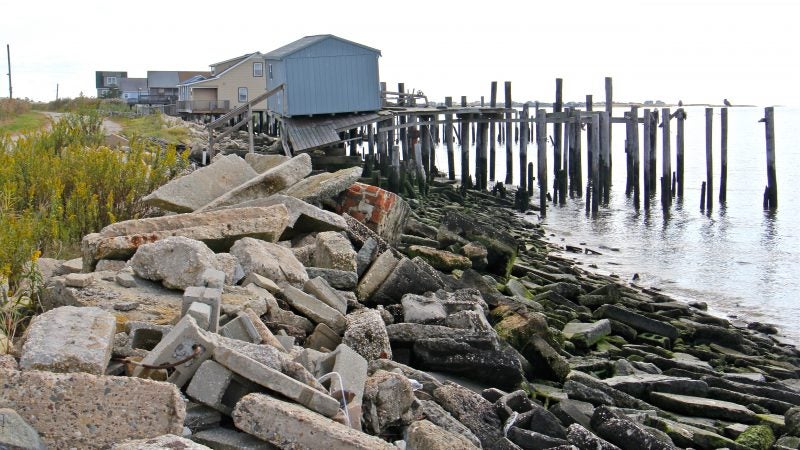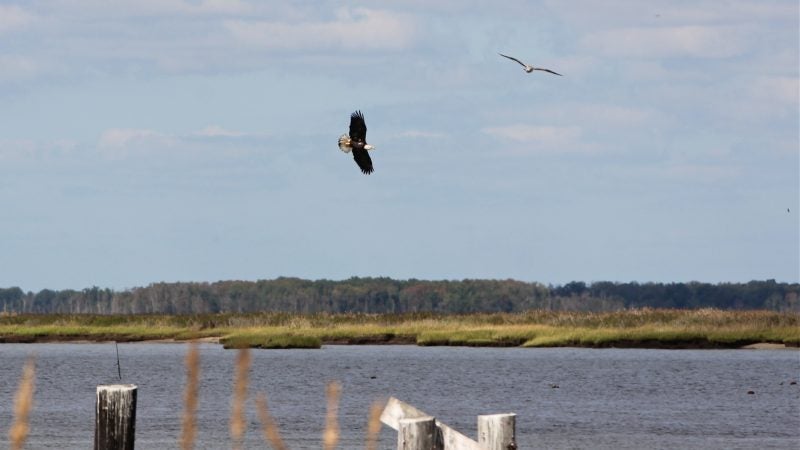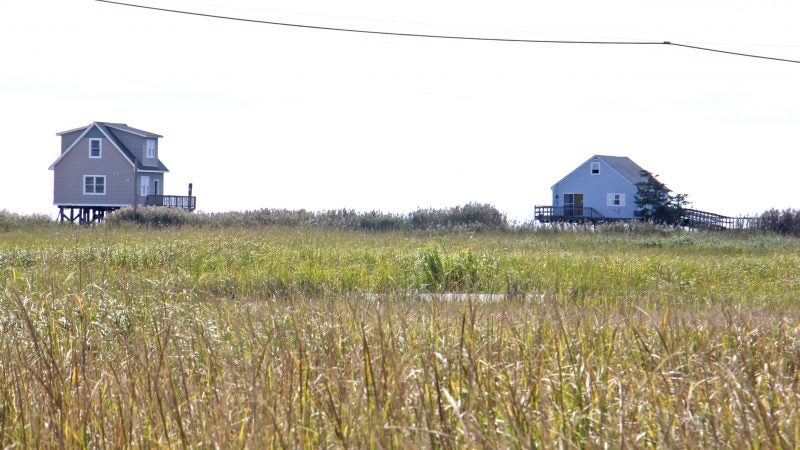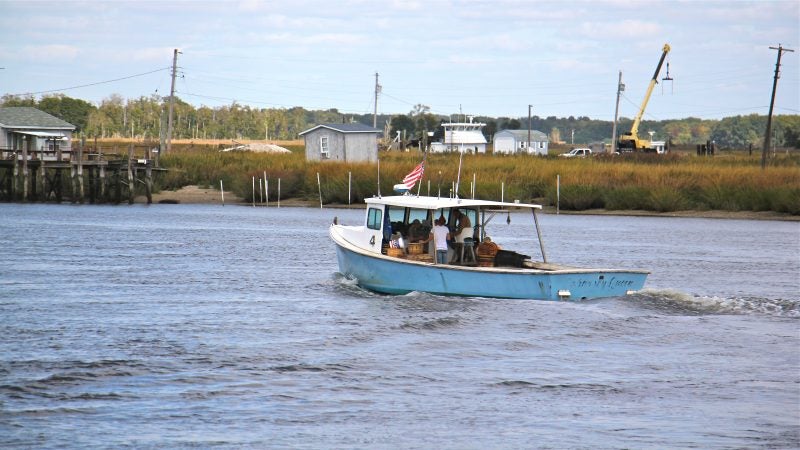Five years after Sandy, tiny Delaware Bay communities struggle to survive
When it comes to help from the state, location matters.
Listen 5:11-

All but two of the houses on the Delaware Bay at Bay Point are slated for demolition and the bayfront will be allowed to return to its natural state. (Emma Lee/WHYY)
-

The construction debris that protected the beach and road at Bay Point will be cleared away when the houses are removed. (Emma Lee/WHYY)
-

G. Erwin Sheppard, who was mayor of Lawrence Township during Hurricane Sandy and still serves on the township council, visits what remains of Bay Point. (Emma Lee/WHYY)
-

A bald eagle soars above Cedar Creek at Bay Point. (Emma Lee/WHYY)
-

Bayside homes to be demolished at Bay Point are marked with numbers painted in red. (Emma Lee/WHYY)
-

A demolition contractor looks at homes along Bay Point Road that were purchased by the state under the Blue Acres program. (Emma Lee/WHYY)
-

A fishing boat sets out from Money Island. (Emma Lee/WHYY)
-

Meghan Wren, director of the Bayshore Center at Bivalve, hopes that oyster reefs will slow erosion and protect the only road to her home on Money Island. (Emma Lee/WHYY)
-

Low tide at Money Island exposes man-made oyster towers. (Emma Lee/WHYY)
-

Low tide at Money Island exposes man-made oyster towers. (Emma Lee/WHYY)
The tiny town of Bay Point, New Jersey is a community far removed from the hustle of modern life. A stroll along this stretch Delaware Bay is accompanied by the sounds of rustling phragmite grasses and water lapping at the shore.
A row of pilings lines the shoreline. Some still support empty homes marked with large orange numbers designating them for demolition.
Five years ago this Sunday, Superstorm Sandy dealt this and other bayfront communities a nearly lethal blow. Most of the few dozen properties along the bay and nearby creek will be torn down this winter. Just a few residents are choosing to stay.
Erwin Sheppard, who was Lawrence Township’s mayor during the storm, said dismantling Bay Point means the loss of about a million dollars in property tax revenues.
It also means the loss of visitors, he said.
“It’s significant, because this is our only bayfront community in the township and there was a lot of economic activity in the town,” he said. “They came in and visited the restaurants and convenience stores, all those people that were coming for the weekends.”
Location is key
When we were last in Bay Point a few years ago, the marina was still operating. It was a gathering spot for crabbing, surf fishing and striped bass tournaments. Now, it is little more than a boat launch and a pile of greenish rubble.
Bay Point is the latest loss along the Delaware Bay, but locals could tell you of Moores Beach, Sea Breeze and Thompson’s Beach. They were all hit by challenging storms in recent decades and all are nearly gone.
Meghan Wren is a longtime resident of Money Island, another community battered by Sandy.
When it comes to help from the state, Wren said, location matters.
“The treatment that the bay shore communities are getting is very, very different than the Atlantic coastal communities that are racking in tourism funds. There are a lot of ratables there,” she said. “So we definitely get a lot less attention, a lot less funding.
“I believe they, the big ‘they,’ would be happier to see us all gone.”
Wrenching decisions
Fawn McGee directs the state’s Blue Acres program, which buys up properties from people willing to move to higher ground.
New Jersey has experienced more than a thousand flood events since the mid-1990s, she said, and the Delaware Bay shore area is particularly vulnerable to flooding and storm surge.
McGee said the state doesn’t ask residents to leave — residents choose to sell and the queries continue to come in.
“As much as they may not want to move away from this area, they recognize how vulnerable it is,” she said. “So we’re here to help. There’s money, so we’ll continue to do it.”
Once properties are demolished, the goal is to restore the land to healthy, natural habitats. Those habitats become parklike areas that are owned by the state and open to nature lovers.
Half of the village of Money Island has been sold, Wren said, and awaits demolition.
Money Island is the primary landing spot for the Delaware Bay oyster industry. To Wren, the idea that this little piece of bay shore paradise will shrink is wrenching. It will feel like an outpost, she said.
“I’ve spoken to a number of people who are just devastated. They’d moved here, retired here, had planned to make this their forever home and their feeling is they don’t have any choice but to sell now, because the whole community is picking up and leaving,” Wren said. “It’s not going to be the way they thought it would be.”
Even with the plan to restore much of the bay shore to natural wetlands that can absorb floodwaters, she said there is still a need for people who are passionate about the area to live here.
“If you just cut it off from human interaction and divorce it from its heritage and the culture of the people appreciating it, you’re not going to have people taking care of it.”
A positive step and a plea for continuity
At the same time, Wren is enthusiastic about efforts to restore areas of the bay. The Living Shoreline project — funded by various sources — implements natural protections, such as spartina grasses and oyster castles, which we spied poking out of the bay at low tide. The structures contain seed oysters intended to help build up reefs. The reefs should then protect the main road and the marsh, which can’t build as much if water aggressively hits against it.
In addition, efforts to restore the bay’s marsh and shoreline should eventually benefit area wildlife, including horseshoe crabs, the red knot, purple martins, ospreys and the bald eagle we spotted soaring above the bay shore.
For Meghan Wren, there is nowhere else like it.
“It’s a really amazing place and, you know, we’re caretakers of that. People can come from all over to experience this,” she said. “There aren’t many places to go in this metropolitan region where you’re looking at something that looks exactly as it did when the Lenape were here 10,000 years ago.
“It really gets under your skin. It’s a place that is difficult to imagine leaving once you’ve got a spot here.”
WHYY is your source for fact-based, in-depth journalism and information. As a nonprofit organization, we rely on financial support from readers like you. Please give today.





